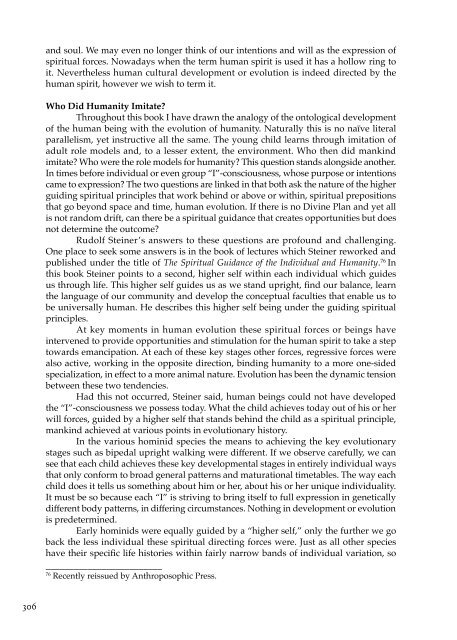The Spirit in Human Evolution - Waldorf Research Institute
The Spirit in Human Evolution - Waldorf Research Institute
The Spirit in Human Evolution - Waldorf Research Institute
You also want an ePaper? Increase the reach of your titles
YUMPU automatically turns print PDFs into web optimized ePapers that Google loves.
and soul. We may even no longer th<strong>in</strong>k of our <strong>in</strong>tentions and will as the expression of<br />
spiritual forces. Nowadays when the term human spirit is used it has a hollow r<strong>in</strong>g to<br />
it. Nevertheless human cultural development or evolution is <strong>in</strong>deed directed by the<br />
human spirit, however we wish to term it.<br />
Who Did <strong>Human</strong>ity Imitate?<br />
Throughout this book I have drawn the analogy of the ontological development<br />
of the human be<strong>in</strong>g with the evolution of humanity. Naturally this is no naïve literal<br />
parallelism, yet <strong>in</strong>structive all the same. <strong>The</strong> young child learns through imitation of<br />
adult role models and, to a lesser extent, the environment. Who then did mank<strong>in</strong>d<br />
imitate? Who were the role models for humanity? This question stands alongside another.<br />
In times before <strong>in</strong>dividual or even group “I”-consciousness, whose purpose or <strong>in</strong>tentions<br />
came to expression? <strong>The</strong> two questions are l<strong>in</strong>ked <strong>in</strong> that both ask the nature of the higher<br />
guid<strong>in</strong>g spiritual pr<strong>in</strong>ciples that work beh<strong>in</strong>d or above or with<strong>in</strong>, spiritual prepositions<br />
that go beyond space and time, human evolution. If there is no Div<strong>in</strong>e Plan and yet all<br />
is not random drift, can there be a spiritual guidance that creates opportunities but does<br />
not determ<strong>in</strong>e the outcome?<br />
Rudolf Ste<strong>in</strong>er’s answers to these questions are profound and challeng<strong>in</strong>g.<br />
One place to seek some answers is <strong>in</strong> the book of lectures which Ste<strong>in</strong>er reworked and<br />
published under the title of <strong>The</strong> <strong>Spirit</strong>ual Guidance of the Individual and <strong>Human</strong>ity. 76 In<br />
this book Ste<strong>in</strong>er po<strong>in</strong>ts to a second, higher self with<strong>in</strong> each <strong>in</strong>dividual which guides<br />
us through life. This higher self guides us as we stand upright, f<strong>in</strong>d our balance, learn<br />
the language of our community and develop the conceptual faculties that enable us to<br />
be universally human. He describes this higher self be<strong>in</strong>g under the guid<strong>in</strong>g spiritual<br />
pr<strong>in</strong>ciples.<br />
At key moments <strong>in</strong> human evolution these spiritual forces or be<strong>in</strong>gs have<br />
<strong>in</strong>tervened to provide opportunities and stimulation for the human spirit to take a step<br />
towards emancipation. At each of these key stages other forces, regressive forces were<br />
also active, work<strong>in</strong>g <strong>in</strong> the opposite direction, b<strong>in</strong>d<strong>in</strong>g humanity to a more one-sided<br />
specialization, <strong>in</strong> effect to a more animal nature. <strong>Evolution</strong> has been the dynamic tension<br />
between these two tendencies.<br />
Had this not occurred, Ste<strong>in</strong>er said, human be<strong>in</strong>gs could not have developed<br />
the “I”-consciousness we possess today. What the child achieves today out of his or her<br />
will forces, guided by a higher self that stands beh<strong>in</strong>d the child as a spiritual pr<strong>in</strong>ciple,<br />
mank<strong>in</strong>d achieved at various po<strong>in</strong>ts <strong>in</strong> evolutionary history.<br />
In the various hom<strong>in</strong>id species the means to achiev<strong>in</strong>g the key evolutionary<br />
stages such as bipedal upright walk<strong>in</strong>g were different. If we observe carefully, we can<br />
see that each child achieves these key developmental stages <strong>in</strong> entirely <strong>in</strong>dividual ways<br />
that only conform to broad general patterns and maturational timetables. <strong>The</strong> way each<br />
child does it tells us someth<strong>in</strong>g about him or her, about his or her unique <strong>in</strong>dividuality.<br />
It must be so because each “I” is striv<strong>in</strong>g to br<strong>in</strong>g itself to full expression <strong>in</strong> genetically<br />
different body patterns, <strong>in</strong> differ<strong>in</strong>g circumstances. Noth<strong>in</strong>g <strong>in</strong> development or evolution<br />
is predeterm<strong>in</strong>ed.<br />
Early hom<strong>in</strong>ids were equally guided by a “higher self,” only the further we go<br />
back the less <strong>in</strong>dividual these spiritual direct<strong>in</strong>g forces were. Just as all other species<br />
have their specific life histories with<strong>in</strong> fairly narrow bands of <strong>in</strong>dividual variation, so<br />
_________________________<br />
76<br />
Recently reissued by Anthroposophic Press.<br />
306
















